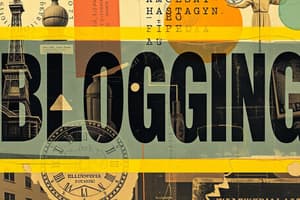Podcast
Questions and Answers
What is the purpose of the 'Credits & Attribution' section in a typical blog entry?
What is the purpose of the 'Credits & Attribution' section in a typical blog entry?
- To encourage readers to share the post
- To acknowledge sources or inspiration for the post (correct)
- To provide links to other blog entries
- To summarize the main content of the post
Why do most blogs display posts in reverse chronological order?
Why do most blogs display posts in reverse chronological order?
- To ensure readers see the newest content first (correct)
- To encourage readers to leave comments
- To make it difficult for readers to navigate the site
- To hide the most recent posts
What is the purpose of the 'Introduction' section in a blog entry?
What is the purpose of the 'Introduction' section in a blog entry?
- To hook the reader's attention and introduce the topic (correct)
- To present the main ideas and arguments
- To acknowledge sources or inspirations
- To encourage readers to share the post
In a blog entry, what is the function of images?
In a blog entry, what is the function of images?
Why might some static 'about me' pages break the reverse chronological order rule?
Why might some static 'about me' pages break the reverse chronological order rule?
What is the primary goal of the 'Conclusion' section in a blog entry?
What is the primary goal of the 'Conclusion' section in a blog entry?
What is the purpose of blog posts in a blog?
What is the purpose of blog posts in a blog?
What is the function of commenting on blog entries?
What is the function of commenting on blog entries?
In what order are blog entries typically displayed?
In what order are blog entries typically displayed?
What is a weblog commonly referred to as?
What is a weblog commonly referred to as?
What makes up the essential components of a blog?
What makes up the essential components of a blog?
What can bloggers create content about?
What can bloggers create content about?
Flashcards are hidden until you start studying
Study Notes
Blogging: A Comprehensive Guide
Blogging is a form of online journaling where individuals share their thoughts, ideas, experiences, and knowledge with others through regular updates on websites known as blogs. This guide will delve into the world of blogging, discussing its definition, essential components such as blog posts and commenting, the reverse chronological order, and the preferred structure of blog entries.
Weblog Definition
A weblog, commonly referred to as a blog, is essentially an online diary or personal journal shared publicly. It consists of periodic entries documenting one's thoughts, opinions, and information on various subjects. Bloggers can create content on any topic they are passionate about, ranging from technology, food, fitness, politics, art, travel, or even daily life experiences.
Blog Posts
Blog posts are individual entries within a blog, serving as the primary means of sharing information and perspectives with readers. They often contain text, photos, videos, or other multimedia elements, depending on the blogger's preference and the nature of the content being presented. Each post has a unique URL for easy access by visitors.
Commenting on Blog Entries
Commenting is a crucial aspect of the blogging community, allowing readers to engage directly with the blogger and each other. By leaving comments below a blog post, users can discuss topics further, ask questions, offer feedback, and foster meaningful interactions. These discussions help build a vibrant community around the blog and contribute to ongoing conversations related to the posted material.
Reverse Chronological Order
In most cases, blog entries appear in reverse chronological order, meaning the latest posts appear at the top while older ones move down the page. This arrangement ensures that readers always see the newest content first when visiting a blog. However, breaking this rule does have some benefits - for example, in the case of static 'about me' pages, which can remain high up on the page regardless of how old they are.
Blog Entry Structure
The typical structure of a blog entry includes several sections:
- Title: A brief, catchy, and descriptive title summarizing the post's content.
- Introduction: A short paragraph introducing the topic and hooking the reader's attention.
- Main Content: The body of the post where the blogger presents their ideas, insights, or arguments.
- Image(s): Often used to enhance the visual appeal and break up large blocks of text.
- Credits & Attribution: If applicable, acknowledgment of sources or inspiration for the post.
- Conclusion: Wrapping up key points and encouraging readers to leave comments or share the post.
Studying That Suits You
Use AI to generate personalized quizzes and flashcards to suit your learning preferences.




